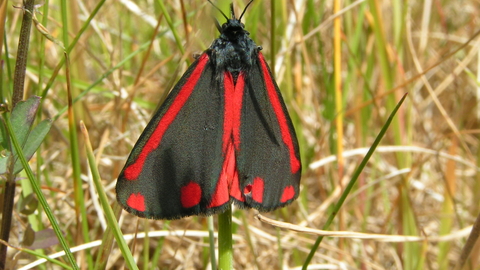These
pretty black and red moths are often confused for butterflies! Their
black and yellow caterpillars are a common sight on ragwort plants. The
caterpillar’s bright colours warn predators not to eat them, giving a
strong signal that they are poisonous!
About
Cinnabar
moths start life as yellow and black caterpillars and are particularly
fond of munching on ragwort plants. Their bright colours warn predators
that they’re poisonous, but they only build up their poison after
feeding on the ragwort. The caterpillars spend the winter as cocoons on
the ground before emerging as moths in the summer. Cinnabar moths can be
seen flying during the day and night and are often mistaken for
butterflies. How to identify
The
cinnabar is slate-black with two red spots and two pinky-red stripes on
the rounded forewings. Its hindwings are pinky-red and bordered with
black. It can be distinguished from the similar burnet moths by its
broader wings and red bars instead of spots.Distribution
Widespread.Did you know?
The cinnabar is named after the red mineral, Cinnabar, an ore of the metal Mercury


ConversionConversion EmoticonEmoticon